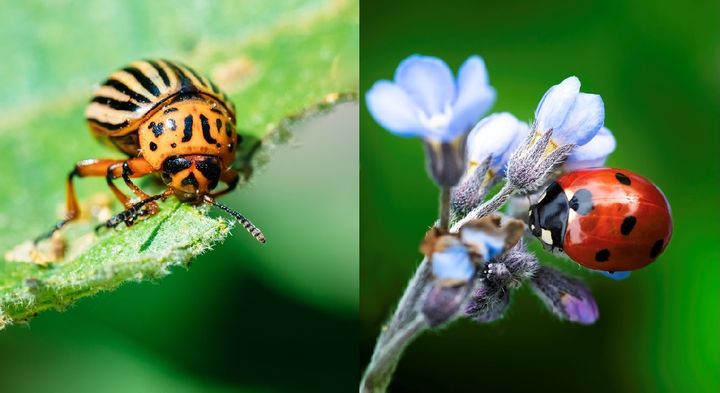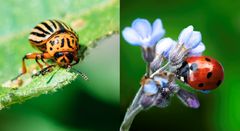How toxic are they? Researchers investigate the environmental consequences of new biotechnological pesticides
Biotechnological pesticides are a promising alternative to traditional chemical pesticides. But we have limited knowledge of how toxic they are to other organisms in the environment beyond regulatory assessments. A new research centre will now work to provide this knowledge – especially to ensure the EU has a chance of joining the growing market for biotechnological pesticides. As for now, Europe has failed to keep up.

"If a thing kills something, we need to know how it kills, and who and what else it may kill," says Professor Nina Cedergreen of the University of Copenhagen’s Department of Plant and Environmental Sciences.
She is referring to biotechnological pesticides, or more specifically, pesticides that consist of all-natural RNA and peptide molecules designed to combat diseases and pests in agricultural crops which make use of cutting-edge biotechnologies. In some countries, they are classified as biopesticides and are believed to be less of a threat to the environment and public health than conventional chemical pesticides, which there is a political ambition to cut back on.
No RNA or peptide products have yet been approved in the EU, however, they are gaining traction in the rest of the world.
"Biotechnological pesticides show promise to make ever-increasing global food production less dependent on chemical pesticides. Manufacturers claim that biotechnological pesticides are environmentally safe because they are based on natural biology. The fact is that these are toxic substances that kill pests and diseases, none-the-less we are only starting evaluating their environmental impact. That’s what we’ll be trying to move forward," says the professor.
Cedergreen heads ENSAFE, a large new research centre that the Novo Nordisk Foundation has funded with DKK 60 million (€8 million). In addition to Cedergreen, the research consortium consists of Jan Gorodkin from the Faculty of Health Science at the University of Copenhagen, Jeppe Lund Nielsen from Aalborg University, and David Spurgeon and Helen Hesketh from UK Centre for Ecology & Hydrology. Together they will provide evidence-based knowledge about the risks of both RNA and peptide-based biopesticides.
A threat to ladybugs and possible allergens?
RNA-based pesticides work by switching off identifiable genes in specific insect pests, viral or fungal diseases, which causes them to die or become unviable.
"Today, we don’t know whether RNA pesticides only kill the pests we target, as there is little public data available on how they affect beneficial insects and other helpful critters. For example, how can we know if a toxin only affects Colorado beetles and not ladybugs? Our hypothesis is that there must be related animals that are sensitive to RNA agents as well. This is a hypothesis that we’ll be setting out to test," says Nina Cedergreen.
Peptide-based pesticides work by mitigating specific enzymes in pests or microorganisms that cause plant diseases. Peptides can for example be hormones or defense compounds. Insulin in humans and spider venom are examples of peptides.
"While peptides are natural compounds, we know that most human allergies are actually triggered by peptides, including pollen and soy allergies. So what and how much does it take for peptides to trigger the immune system of other organisms than humans? These are among the questions that we’ll need to answer," says Nina Cedergreen.
The researchers aim to answer two overarching questions: To what extent can humans and organisms be exposed to biotechnological pesticides when they are used as directed for agriculture? And, to what degree are these amounts toxic?
"By acquiring this knowledge, we’ll be able to assess the overall risk of a pesticide. If a toxin disappears quickly from the environment, the risk to both humans and the environment tends to be relatively limited, as we won’t be exposed to it. However, it is well known that peptides, for example, can take quite a long time to break down. So will any toxins from the field remain in our foodstuffs when they reach the supermarket? This is what we need to know," says the professor.
Europe lags far behind
Authorities in many countries have adapted their approach to biopesticides, where several products are already in use, including in the United States, South America and Asia. The situation is different in the European Union.
Regardless of whether a plant protection product is natural or a synthetic chemical, pesticides must go through the same restrictive approval process in the EU; a process that typically takes 5-10 years and costs applicants roughly €45 million. However, the problem isn’t just that the approval system in the EU is slow and expensive – it is also not geared to the new biotechnological pesticides.
Professor Cedergreen explains “The European approval system is tailored specifically for chemical pesticides, leading to some odd contradictions. For instance, the system may require you to provide a boiling point for a substance made up of living microbes, which clearly doesn't apply. This highlights how certain aspects of the current approval process simply don't make sense. She points to the time horizon as another critical obstacle:
"Many companies are currently developing biotechnological pesticides. Start-ups, however, cannot afford to wait a long time before they know if they have a market and can begin making money. That's why they look beyond Europe, which leaves us behind," says Nina Cedergreen, continuing:
"This is the dilemma Europe is facing. We want to be careful about what we spray onto our food and feed. But it is unwise if we are so restrictive that we miss out on the biotechnological development booming around the world. Such developments can potentially produce better and less environmentally harmful plant protection products which ultimately will replace chemical pesticides."
The ambition of the new research center is therefore to develop the tools necessary for the EU to efficiently assess the environmental risks of various biopesticides.
"We need to create the knowledge we lack to regulate new biotechnological plant protection products in a safe way, as well as in a way that is smarter and faster than the process that chemicals currently need to go through in the EU," concludes Professor Cedergreen.
[BOX] BIOPESTICIDES OR BIOTECHNOLOGICAL PESTICIDES?
Biopesticides are biological substances or organisms that damage, kill or repel crop pests or diseases. They can be extracts of plants or microbes, or living microbes, parasites, predators or diseases targeting crop pests. They can also be pheromone traps or pheromones released to e.g. confuse male moths during the mating period, thereby preventing fertilization of the eggs of the female months, which leads to less moth-larvae damaging the crop.
Biotechnological pesticides are, for example in the USA, defined as biopesticides, as they consist of biological molecules. Biotechnological pesticides, however, differ from e.g. whole microbes or plant extracts by being designed to inhibit the growth and development of pests and diseases. The biomolecules can be RNA, which consists of nucleic acids naturally present in all living organisms. Or it can be peptides, which are short strings of amino acids, the building blocks of all proteins. The inspiration to the designs is often taken directly from already excising molecules, or is based on knowledge of biology’s own defense towards pests and diseases. The design can potentially make biotechnological pesticides very specific, so only the pests are killed leaving beneficial organisms unharmed.
[BOX] MACHINE LEARNING WILL IDENTIFY SENSITIVE SPECIES
The Research Center ENSAFE will also investigate if it is possible using machine learning tools to predict which organisms will be sensitive to specific biotechnological pesticides.
“With the quickly growing genome-databases as inputs, AI tools can likely be developed to screen species for the gene-combinations that the biotechnological pesticides are designed to shut down. This would make it possible to target the studies required by industry for regulatory purposes towards the most sensitive species” says Jan Gorodkin.
Keywords
Contacts
Nina Cedergreen
Professor
Department of Plant and Environmental Sciences
University of Copenhagen
ncf@plen.ku.dk
+45 35 33 33 97
Maria Hornbek
Journalist
Faculty of Science
University of Copenhagen
maho@science.ku.dk
+45 22 95 42 83
Images

Links
ABOUT THE FACULTY OF SCIENCE
The Faculty of Science at the University of Copenhagen – or SCIENCE – is Denmark's largest science research and education institution.
The Faculty's most important task is to contribute to solving the major challenges facing the rapidly changing world with increased pressure on, among other things, natural resources and significant climate change, both nationally and globally.
Subscribe to releases from Københavns Universitet
Subscribe to all the latest releases from Københavns Universitet by registering your e-mail address below. You can unsubscribe at any time.
Latest releases from Københavns Universitet
Forskere genopliver gamle ærtesorter i enorm frøsamling: ”Et uudnyttet guldkammer til fremtiden”15.12.2025 10:29:09 CET | Pressemeddelelse
Med en ny AI-metode har forskere fra Københavns Universitet genopdaget 51 gamle ærtesorter, som ikke længere bruges i landbruget, men som kan vise sig lovende til produktion af plantebaserede fødevarer. Metoden er en genvej til at finde nye ressourcer i de grønne skatkamre, som genbankers enorme frøsamlinger udgør.
Fermentering gør havets grøntsager mere spiselige5.12.2025 06:18:59 CET | Pressemeddelelse
Tang har længe været hyldet som en bæredygtig superingrediens – men dens “fiskede” smag er en barriere for mange vestlige forbrugere. Nu viser et nyt studie fra Københavns Universitet, at fermentering med mælkesyrebakterier kan være nøglen til at få tangen til at glide ned.
P-piller kan forringe kvinders mentale trivsel2.12.2025 06:05:00 CET | Pressemeddelelse
Adgang til p-piller i ungdomsårene er forbundet med øget risiko for depression senere i livet. Især kan kvinder, der er genetisk disponeret for psykisk sygdom, risikere at blive ramt af bivirkningen. Det viser et nyt studie fra Københavns Universitet.
Psykologer: Derfor kan protester samle folk på tværs af politiske skel27.11.2025 09:18:05 CET | Pressemeddelelse
Hvordan kan mennesker med diametralt modsatte holdninger pludselig stå skulder ved skulder i protest? Det spørgsmål har et internationalt forskerhold undersøgt. Udgangspunktet er COVID-protesterne, som blev båret af tre samlende strategier.
Sådan bruger planter ingeniørprincipper til at trænge gennem hård jord27.11.2025 07:16:00 CET | Pressemeddelelse
Et internationalt forskerhold med Københavns Universitet, Shanghai Jiao Tong University og University of Nottingham i spidsen har opdaget, hvordan planterødder er i stand til at trænge igennem hård og tæt jord ved hjælp af et velkendt ingeniørprincip. Opdagelsen kan få stor betydning for fremtidens afgrøder i en tid, hvor presset på landbrugsjorden stiger.
In our pressroom you can read all our latest releases, find our press contacts, images, documents and other relevant information about us.
Visit our pressroom